How to Beat the YouTube Algorithm and Get Your Videos to Rank Better
Drew Gula
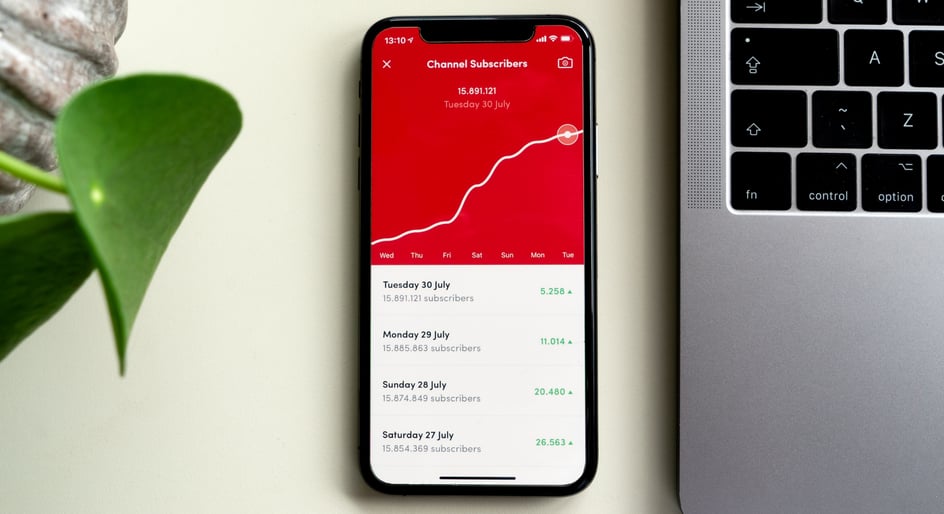
Jan 17, 2022
Let's skip the pleasantries and get right to some statistics:
To summarize: YouTube is a big deal. One of the biggest deals in the 21st century, in fact. It's a platform where 37 million channels produce content that entertains, educates, and engages people every second of every day.
And all of those content creators are uploading 500 hours of videos every minute. Which is both an incredible, mind-boggling feat...but also awfully intimidating.
Because let's face it: You're a content creator. Whether you are an indie filmmaker, a vlogger on the rise, the video guru at an ad agency, or something else, you're here — reading this article — because you want to understand how YouTube's algorithm works and what you can do to beat it.
In other words, you want to know how to rank your videos and show up in search results, suggested videos, or even the YouTube homepage.
And you're in luck, because that's exactly what we're going to dive into right here.
Put simply, YouTube's algorithm is the system that decides what video content people will discover on YouTube. The process handles this a few different ways, from search results ("Which videos does the user really want to watch for this keyword/search term?") to suggested videos ("What videos are like this one that would keep viewers watching?").
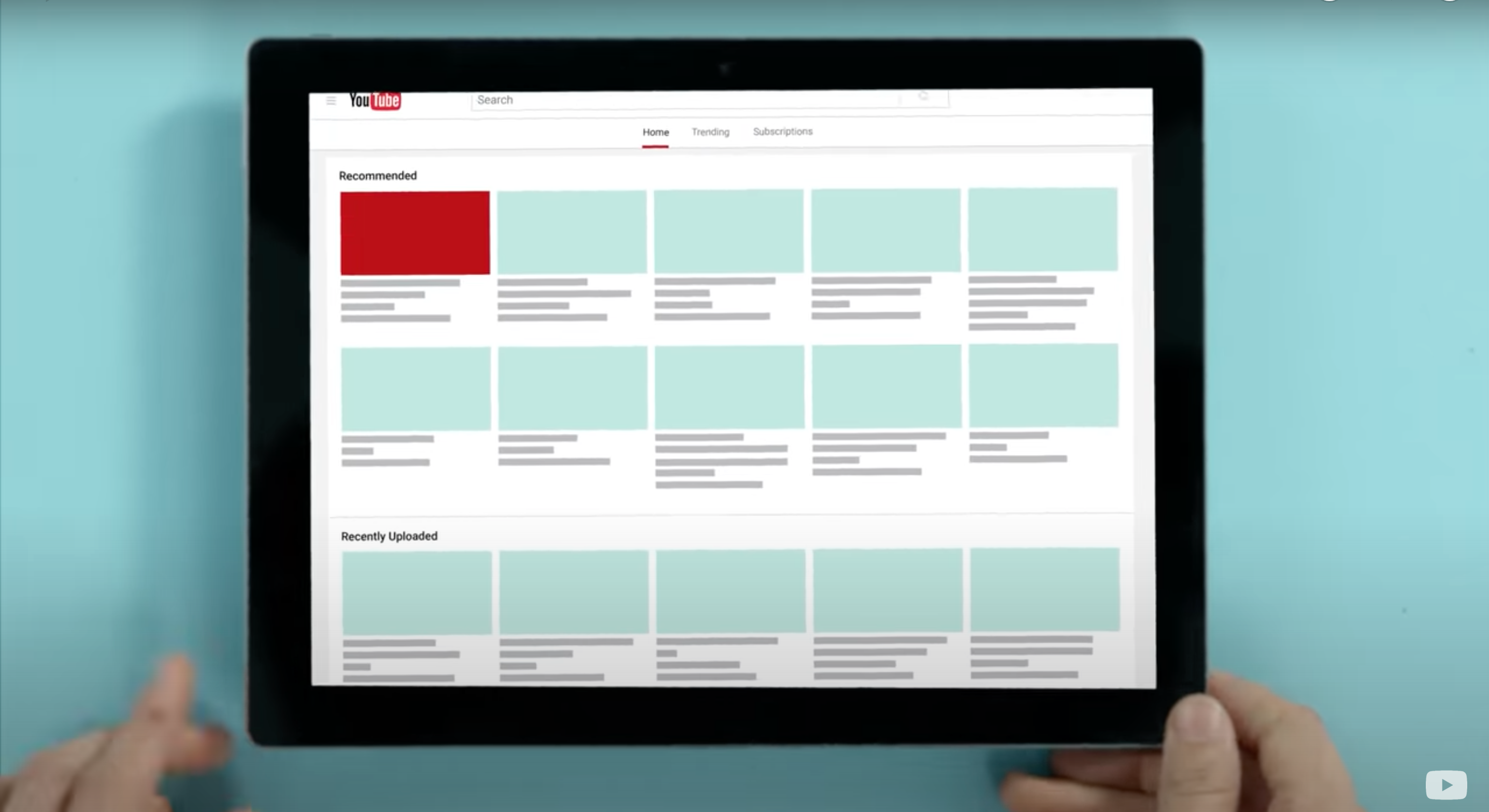
YouTube Academy's tutorial on how the algorithm works
If those questions and ideas feel a little cold and calculating, they are. The algorithm isn't a complex formula like something you'd imagine on Albert Einstein's chalkboard. It's a "living" thing, an AI-powered system that observes our viewing behavior and then helps curate videos it thinks we will like.
But before you grab a tinfoil hat and run for your underground bunker, don't worry — Skynet hasn't taken over, and there aren't Terminators living among us.
Probably not, anyway.
I mean sure, the algorithm evolves and "learns." But it exists solely to give you the best viewing experience on YouTube. And the other side of the coin is that it helps YouTube better understand how creators use the platform to grow their YouTube channels.
For content creators who invest time in understanding how the YouTube algorithm works, it's something you can use to your advantage, to help you get your content in front of viewers and grow a YouTube channel.
It's the sort of hack you need to stand out among 37 million other creators all fighting over the same YouTube audience...even if that audience is 2 billion and growing.
Back in the early 2010s when YouTube was exploding into the platform we know now, the site faced the same issues we see on other social media platforms today: It was overflowing with garbage content.
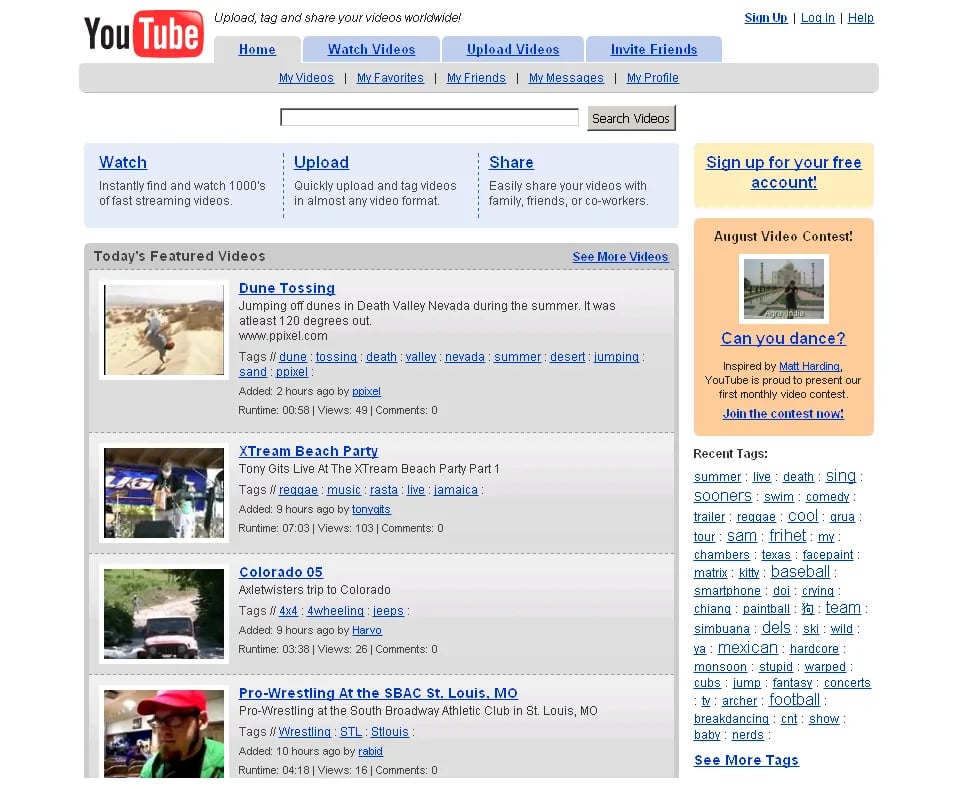
Here is a look at some classic YouTube designs
Clickbait videos ran wild across the video platform. (Remember the awful "Rickroll" fad?) At some point, a few crafty engineers realized they needed someone to patrol the platform — a sort of caped crusader who would protect the fine digital citizens of YouTube.
More specifically, they needed something capable of filtering out the junk. Something that would streamline and improve the search feature while also helping people find YouTube videos they actually wanted to watch. And it wouldn't be enough to just base search results based on each user's watch history or videos uploaded recently.
No, YouTube needed something a whole lot more complex they that.
We're still benefiting from YouTube's algorithm years later. YouTube's homepage is overflowing with curated content for each user. (Personally, I rarely have to search for stuff to watch anymore.) And the suggested videos guide people to relevant content that might become their favorite new channel to subscribe to.
YouTube's algorithm has changed over the years, and machine learning has transformed it from a behind-the-scenes filter to a highly sophisticated content sommelier. And that has helped the platform continue to grow, with engagement numbers on the rise ever since.
As of 2020, the average American adult spent over 24 minutes on YouTube every day — it's not hard to attribute that watch time to how the YouTube algorithm works.
Well, you want people to watch your videos, right?
If you invest time and effort to make videos, then you probably planned for people to find and watch them. And if you've done any research on YouTube SEO, you have at least an idea about keywords, tags, and the importance that your video's metadata can play in how easy it is for people to find your content. Or if you go deep into the analytics dashboard, you might be more focused on watch time for your new videos and click through rate to your YouTube channels.
After all, if creators are uploading 500 million hours of content every single minute, you're going to want your videos to appear among YouTube's search results. And the only way to do that is to make sure that the algorithm will actually rank your videos for the keywords and tags you want.
Things like the video title matters of course, and how you approach your video thumbnails can actually have an effect on whether or not the YouTube algorithm recognizes your content as an authority on the topics you cover. These are small SEO tricks to convince YouTube's AI "search filter" that your videos belong near the top of the list when people are browsing content.
Of course, it's easy to see those SEO tricks and YouTube's algorithm as a way to set you up for success. Learn a few loopholes and suddenly you're pumping out trending videos every day with hundreds of new subscribers.
...but that's just not the case.
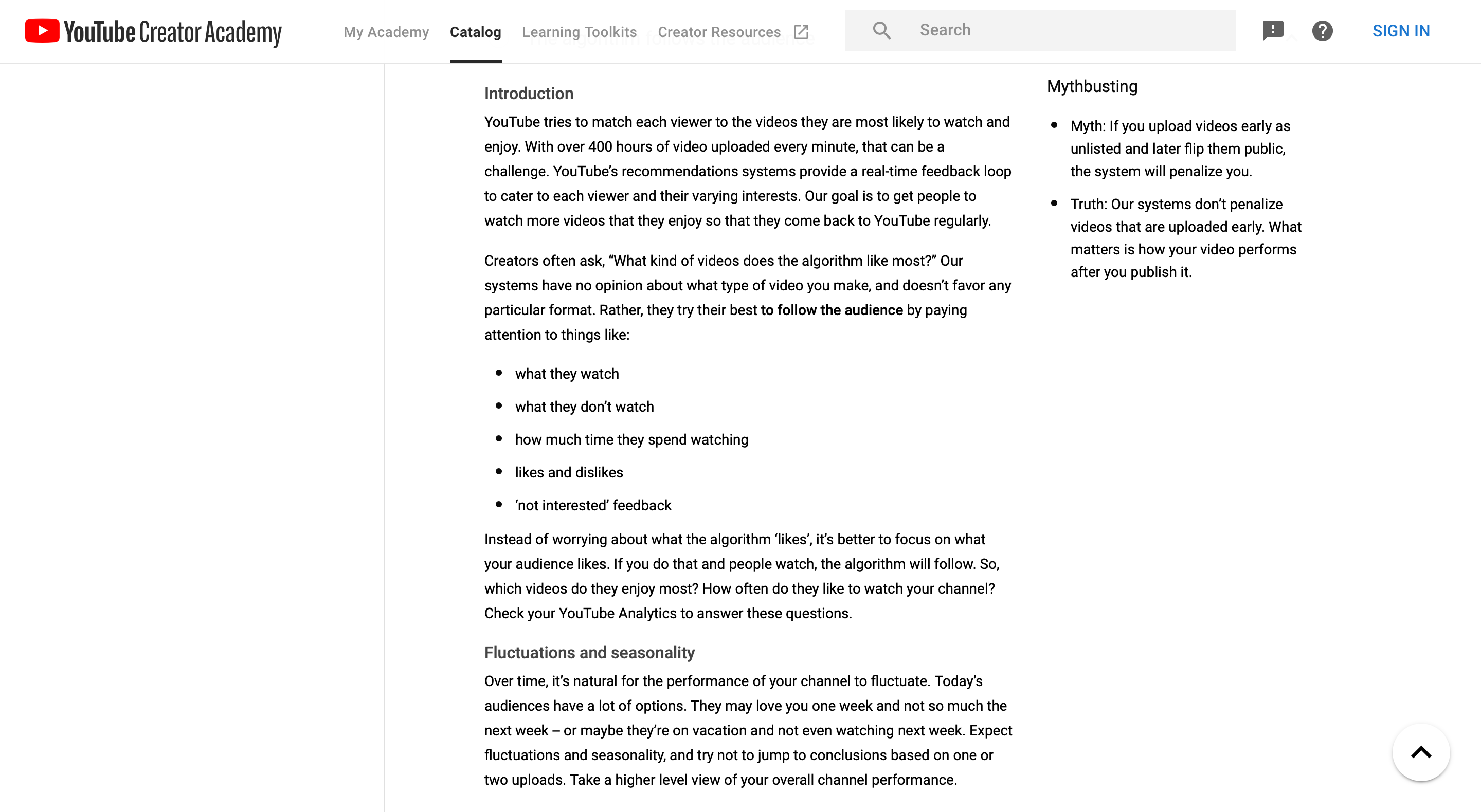
YouTube algorithm tips and tricks
As a content creator, it’s important to remember that YouTube's algorithm is a way to help viewers find videos to watch and not the other way around. The system is designed to keep people entertained and boost watch time, not as an explicit way to help you grow your channel.
(If you’re interested in starting a channel from scratch or growing your current YouTube channel, we have guides on both of those. And yes, the YouTube algorithm affects everyone the same, from first-time creators to people with millions of subscribers.)
Unfortunately, we’ll have a hard time breaking down the specifics of how the YouTube algorithm works because YouTube/Google aren't exactly forthcoming on how the magic works.
While the name suggests there’s a formula behind the search algorithm, nobody really knows how it all comes together behind the scenes. We can notice trends over time, but part of YouTube's success is the machine learning process — the algorithm is constantly changing to meet the needs of viewers.
We can tie some of this to YouTube SEO, however. And that’s something we can build on, because the better job you do on those details, the more likely your videos will show up when people search a specific term or phrase.
With even more work, you may actually start to show up in the Suggestions sidebar. That’s when you know you’ve made it, and when your videos will start to skyrocket in terms of viewer counts and engagement.
Speaking of the Suggestions sidebar, it might also help to know that YouTube split up its algorithm process into two separate systems. The homepage algorithm (which is basically built on YouTube SEO principles) and the suggestions algorithm (which is much more aligned with engagement, predicting things you would like based on your viewing history).
If you’ve got a growing fear of artificial intelligence and how AI is gradually infiltrating every face of your life, then I’ve got bad news for you: YouTube — and Google as a whole — is going to be nightmare fuel for you.
However, the good news is that it means you get a curated experience every time you open YouTube. If you’ve ever thought, “Wow, these suggestions or search results are really on point today,” that’s why — the predictive algorithm wants to keep you engaged, and it actually does so by giving you more great videos that you enjoy.
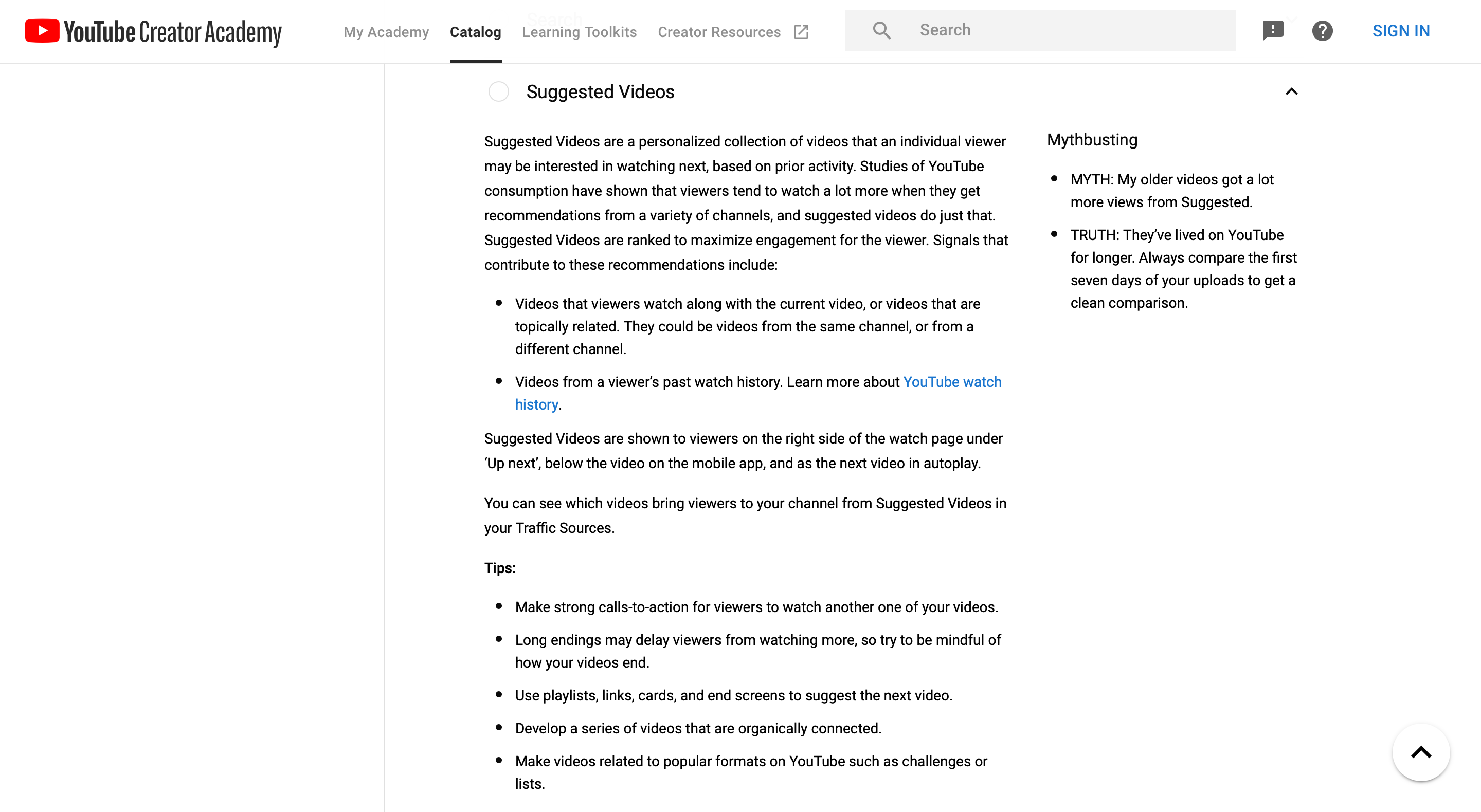
Suggested videos help improve watch time rates on YouTube
It’s a tradeoff. On the one hand, the idea of organically discovering something new is a thing of the past. But on the other hand, it’s never been easier to “stumble” onto a video or new channel that you are almost certain to enjoy.
And because watch time is a clear indication of engagement and video performance , the length of time someone spends watching one of your videos tells the algorithm that your other videos are worthwhile (even if they cover different topics or target different audiences).
So the YouTube algorithm is a mystery. Now what?
Well, just because you don’t understand how something works doesn’t mean you can’t find ways to make it work for you. After all, most of the greatest human achievements happened because some bold pioneer was like, “Why not?” What if your YouTube channel could be that next huge story we all celebrate for years to come?
The system started out as a way to get videos in front of the ideal audience, but YouTube (and social media in general) has evolved as a platform for marketing.
While I won’t say that Google cashed in on a way to monetize YouTube, it’s clear that ad revenue did play a part in creating the model of YouTube analytics we have today. In 2021, the platform is focused on leading viewers to content that will keep them on YouTube longer.
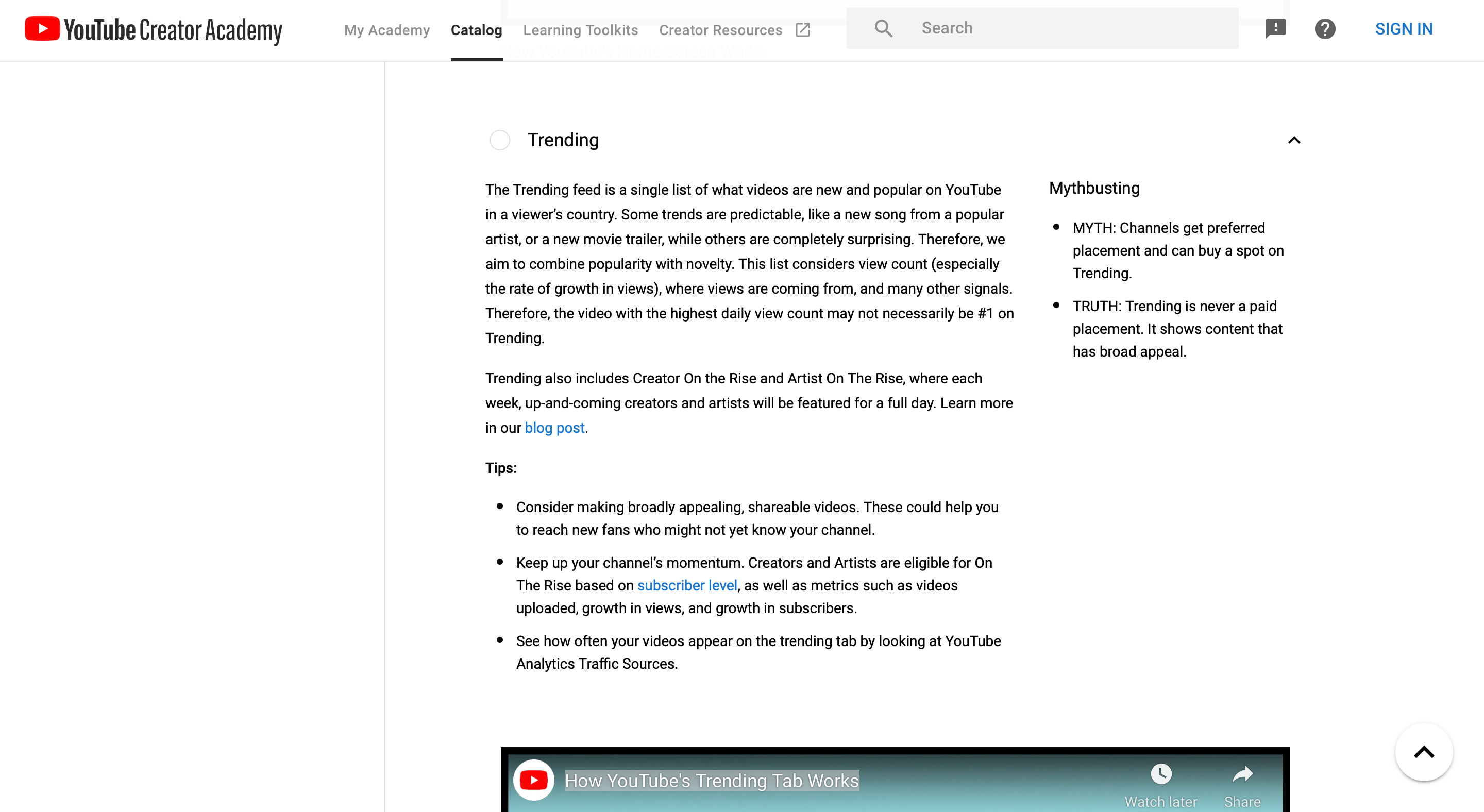
How YouTube's trending video system works
In other words: Engagement is king. YouTube doesn’t care how well-crafted your video is, or even how many subscribers your channel has. If a video is generating shares, likes, and comments, then those numbers can actually carry more weight than traditional view counts.
That leads into the renewed focus on trending content. Like we've seen on Instagram, TikTok, and other social media platforms, the concept of going viral is still a huge pull — the sort of thing that causes huge traffic spikes and can catapult a content creator or a YouTube channel to celebrity status.
But it's not a sort of thing that you can plan for, or even work towards. And trendy topics or titles won't convince the YouTube algorithm to rank videos for a viewer unless the content matches the criteria unique to that individual profile.
It’s not a perfect explanation, because — again — the YouTube algorithm is shrouded in secrecy. But in 2018, YouTube’s product chief said that for the average viewer, 70% of their time on YouTube was spent watching videos recommended by the algorithm.
We can assume that the system has continued to change over the past 3 years. But for all those changes, it's clear that the specific goal of keeping people entertained (watch time) and engaged (click through rate) are still the driving force behind the YouTube's search algorithm and suggested videos section.
With everything we've covered, it's possible that you think that YouTube search and suggested videos are about as comprehensible as a textbook written in Egyptian hieroglyphics. And in some ways, you aren't wrong. (The mind of an AI is an unknowable thing...which might be why nobody has managed to crack the YouTube algorithm yet.)
But the truth is that there's enough data out there to come to some strong conclusions about how it all works.
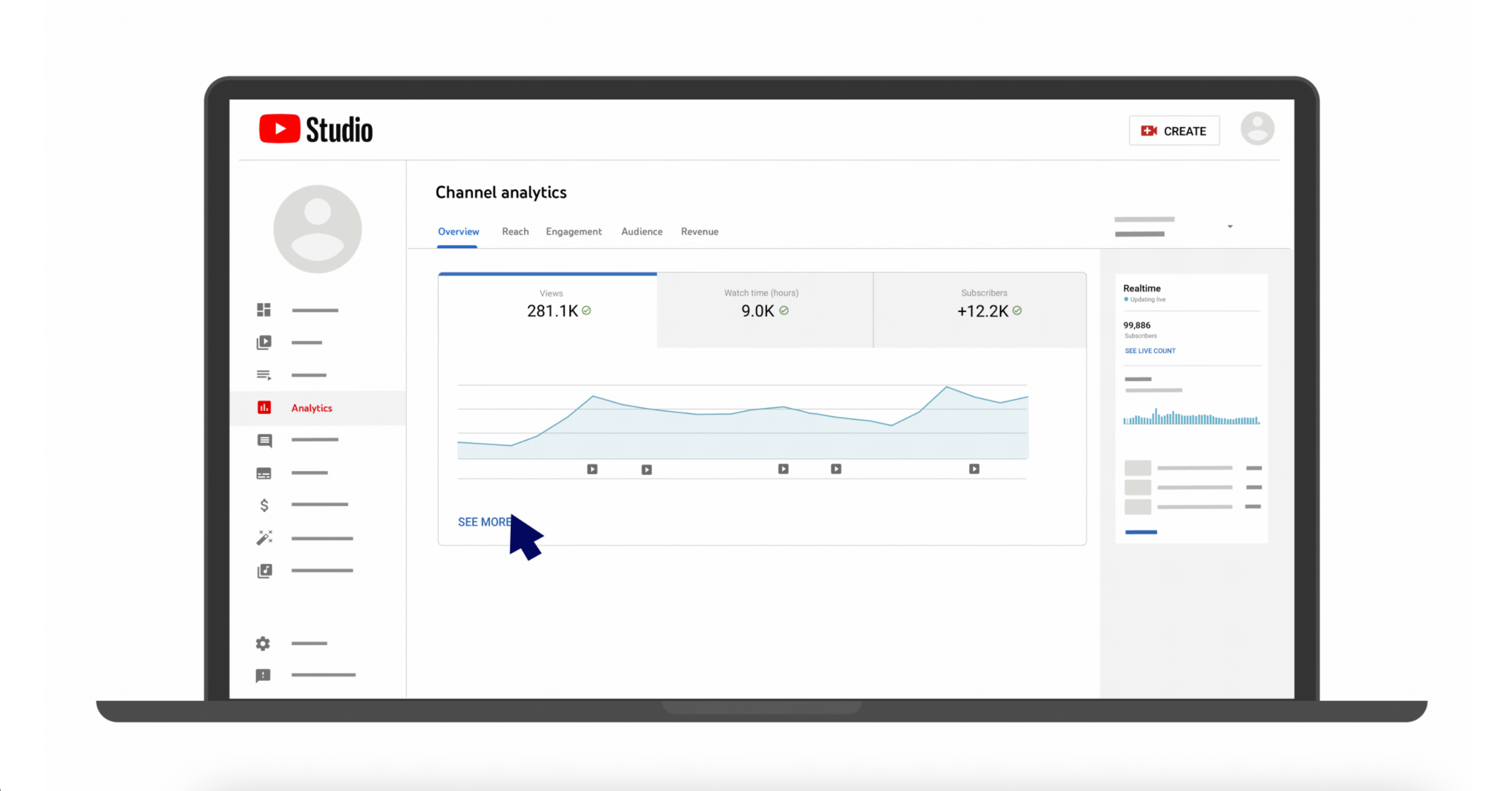
YouTube's channel analytics dashboard
More importantly, we can use that information to make a plan for how you can make the algorithm work for you, boosting your watch. time and drawing new viewers to your next video.
In some ways, the logic behind the keywords will be your best bet to finding success with getting your videos to outrank other videos in the results of a YouTube search. You may think that a broad target will attract a wider audience, but that approach runs some risks. YouTube might determine the video is too general for its algorithm, and all your hard work producing content will go to waste.
The more specific, focused your content is, the more impressed YouTube's algorithm will be with it. And once you are producing content that YouTube sees as an authority on specific topics, the better the odds that the platform will start suggesting new videos to more and more people.
Beating the YouTube algorithm is going to take some work. But it’s absolutely possible, whether you’re only now starting to build a channel or whether you’ve been churning out content for 10 years.
Here are some more articles with advice about how you can find success on YouTube: